


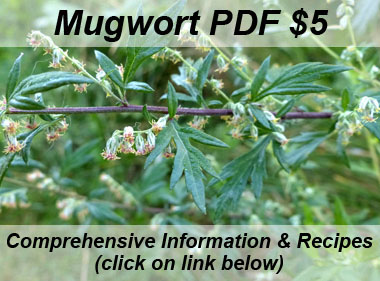
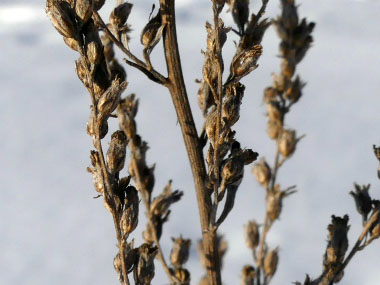

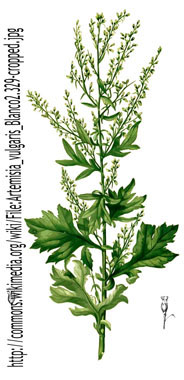
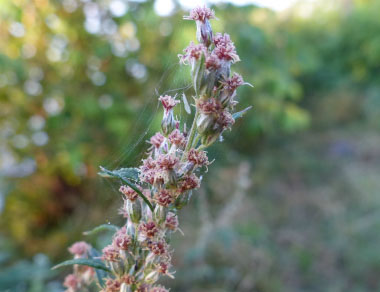

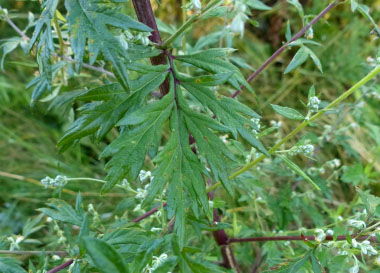

For comprehensive information (e.g. nutrition, health benefits, recipes, history, harvesting tips, etc.) please check out our Mugwort PDF magazine.
Mugwort is a member of the Asteracea family and has a very long and interesting history as food and as medicine. Throughout the years mugwort beer has been a favourite in several cultures. This edible plant can be confused with wormwood (Artemisia absinthium). Examination of the leaves is how to tell the difference. Mugwort leaves are green on the top and white underneath, and they have pointed tips and purplish stems, while wormwood leaves have a silvery top and bottom and the flowers are more showy. Mugwort is native to Europe and Asia but has naturalized through much of the world.
Distinguishing Features
Mugwort flowers are quite unique as disk flowers grow in panicles, they are very small, and they are reddish or greenish yellow. These flowers are not showy. The leaves are deeply lobed and they have a distinctive aroma. Stems are for the most part without hair except for the upper flowering stems and they typically grow to about 1 metre (3') tall.
Flowers
Flowers are numerous, arising in short, erect racemes or branching clusters (panicles) in the upper leaf axils. The flower heads are small and indistinct, 3mm (1/8”) across, petal-less, short stalked or stalkless, egg shaped, erect to drooping. Flower parts are yellow to reddish brown, with 7 to 10 pale yellow, thread-like pistils extending out from the center. Bracts, stalks and stems are light green from frosty hairs.
 Fields
of Nutrition has medicinal benefits and vitamin/mineral content of Mugwort.
Fields
of Nutrition has medicinal benefits and vitamin/mineral content of Mugwort.
Leaves
Leaves are alternate and can grow up to 10cm (4") long and 7cm (3") across. They become smaller in size and more narrow as they ascend the stems. The upper surface of these leaves is green and they are hairless, while their lower surface is white with fine pubescent hairs. The lower and middle leaves usually have 1 to 2 pairs of deep primary lobes that are often irregularly spaced; these primary lobes are often shallowly cleft by one or more secondary lobes, or they have may a few large teeth. At the base of these leaves, there are often 1 or 2 small eared lobes.
Height
Mugwort can grow from 1 to 2 metres (3 to 6') tall on an erect purple-tinged stem.
Habitat
Mugwort prefers growing in waste areas, disturbed areas, along railroads, edges of woods, and in prairie restorations. It prefers full or partial sun and moist to slightly dry conditions. It is very tolerant of a wide range of climatic conditions and is reported to occur from the high mountainous regions of the Northern Himalayas to the warm temperate regions of South America. The only two continents where it has not been documented are Africa and Antarctica.
Edible Parts
Mugwort leaves are aromatic and slightly bitter, and can be eaten raw or cooked. Young spring shoots can be cooked. Leaves, flowers and roots can be used as a tea. Mugwort was commonly used as a flavouring in beer until hops became popular.
Other Name
Cronewort.
Similar Plants
Artemisia absinthium.
Recipes
To support our efforts please browse our store (books with health benefits, etc.).
Winter Survival Food Handbook

PDF Plant Magazines
Types of Wild Food
Geographic Zones Seasons
Disclaimer
EdibleWildFood.com is informational in nature. While we strive to be 100% accurate, it is solely up to the reader to ensure proper plant identification. Some wild plants are poisonous or can have serious adverse health effects.
We are not health professionals, medical doctors, nor are we nutritionists. It is up to the reader to verify nutritional information and health benefits with qualified professionals for all edible plants listed in this web site. Please click here for more information.
Why Edible Wild Food?
- Food costs are rising
- Free, wild food is readily abundant
- Wild food adds nutrition to your diet
- Wild food can help treat various medical conditions





